The global shift to cleaner energy to combat climate change has been driving industries to radically green their operations to economically thrive and remain relevant for years. The mining industry, however, is one of the most important industries that will help the world in achieving net-zero goals. A greener future is impossible without mining by-products as well as the sector’s adoption of climate-smart mining technologies.
How important is the Mining Industry in the Global Energy Transition?
The mining industry has a pivotal role in providing critical raw materials needed for the adoption of clean energy. Copper, lithium, nickel, cobalt, manganese, rare earths, etc., are significantly needed to power electric cars, batteries, and renewable resources. For instance, an electric vehicle requires six times more minerals than fossil-fuel-powered cars (See Figure 1), while wind farms need seven to ten times more than natural gas-powered generation sources (See Figure 2)1).
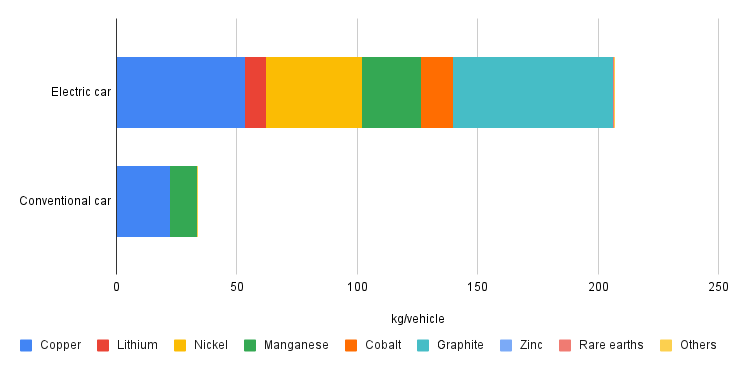
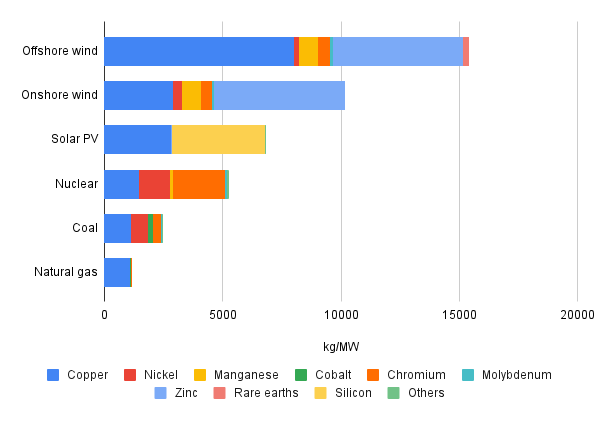
While low-carbon technology is mineral intensive, it provides a critical path towards a net zero future. The World Bank reported that the demand for certain minerals to manufacture renewables and energy storage is expected to grow by 500% in the next three decades, to achieve the below 2°C Paris Agreement temperature goal 4.
The soaring demand for these raw materials presents significant economic opportunities to resource-rich countries and mining companies alike. Investments are soaring to support the entire value chain of mineral production globally 5. Canada, for instance, has invested an unprecedented $3.8 billion to increase the country’s mineral extraction to support the growing electric vehicle (EV) market 6. Meanwhile, investment bids from private sectors and governments are pouring into Argentina’s rich lithium resource. As of 2022, the nation has the highest share of the world’s lithium pipeline projects 7 (See Figure 3).
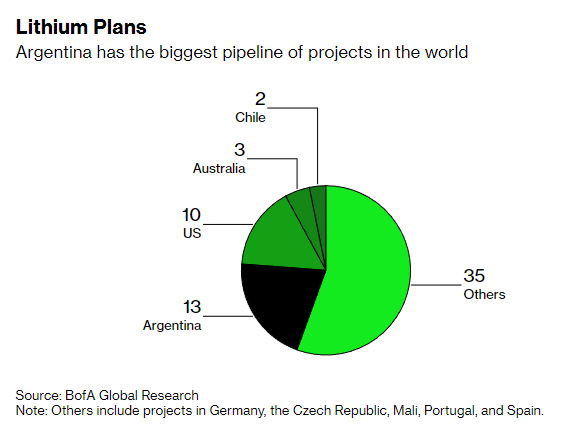
On the other hand, some challenges come with increased minerals and metal extraction to support the cleantech shift. The scrutiny mainly stems from the fact that the industry is known for being carbon and energy-intensive. Increasing mining activities for clean energy supplies, though, will only be 6% of the nonrenewable industry’s greenhouse gas emissions (GHG), according to the World Bank 4. In reality, it is the mining sector’s Scope 3 emissions (indirect emissions that are beyond the industry’s control) that contribute 28% of global emissions, due primarily to the burning of coal that should be of concern8. For this reason, the sector faces strong pressures from key stakeholders to sustainably and responsibly become a welcome and vital part of the green future.
Adoption of climate-smart mining practices
Management consulting firm, McKinsey & Company, identified three ways of how miners can decarbonize their value chain to help alleviate emission concerns and climate risks. This includes operational efficiency, electrification, and the adoption of renewable energy8.
Increase operational efficiency
Digitalization is one of the main key drivers of increasing a mine’s operational efficiency. The market share of IoT solutions, such as machine learning and artificial intelligence, in the mining industry is expected to increase significantly in five years, according to a Research and Markets report9. Tools and instrumentation that allow for real-time data monitoring help stakeholders make informed decisions from anywhere in the world, reduce risks and threats to assets, and make process improvements to achieve efficiencies (Research and Markets, 2022)9.
Asset tracking solutions are also forecasted to grow substantially as they aid in ensuring the safety, efficiency, and productivity in the mining environment. This entails, among others, tracking and optimizing mining trucks’ route, mileage, fuel consumption, collision avoidance, etc., as well as other technologies to efficiently track underground mining activities and improve worker safety9.
Cloud computing is also gaining ground in enhancing the sectors’ operational efficiency, due to enhanced IT security, speed, flexibility, and affordability9. This technology is economical, especially for mining operations in off-the-grid areas, where it is more costly to set up physical infrastructure and logistics systems10. More importantly, data stored in the cloud and accessible 24/7 allows for real-time monitoring and implementation of mitigation decisions and actions when needed, including for staff off-site in between work rotations.
Shift to electrification
Electrifying mining assets is another way miners can become more environmentally responsible. Fully electric trucks and machinery do not produce emissions, generate 87% less heat, and are more cost-effective to maintain in the long run compared to diesel-powered ones11. The use of electric vehicles is the most practical and easiest to implement according to a GlobalData report (see Figure 4). The world’s largest gold mining company, Newmont, for example, recently replaced all of its diesel trucks with battery-powered vehicles in its Golden Borden project in Ontario, Canada, reducing 50% of the site’s total GHGs12.
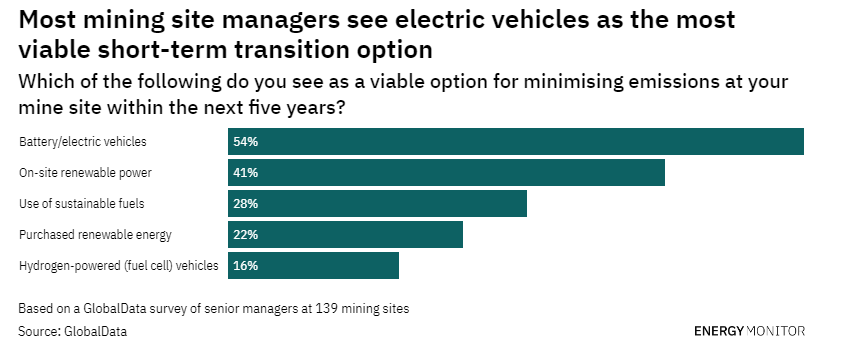
Use of renewable energy
With the price of battery packs forecasted to drop by 50% by 2030, the transition to renewable energy sources, even in remote locations, is becoming more and more attainable8. Key industry players have started to invest in or integrate renewables into their operations (see Figure 5). The world’s second-largest mining company, Rio Tinto, for instance, has invested almost US$100 million into its new solar power plant to generate electricity at its Gudai-Darri (Koodaideri) iron ore mine in Australia14. BHP has been progressively greening its power supply, with four Power Purchasing Agreements (PPAs) in Chile for its operations in the world’s largest copper mine, Escondida15. British multinational mining company, Anglo American, has also secured 100% renewable energy sources for all of its South American operations16.
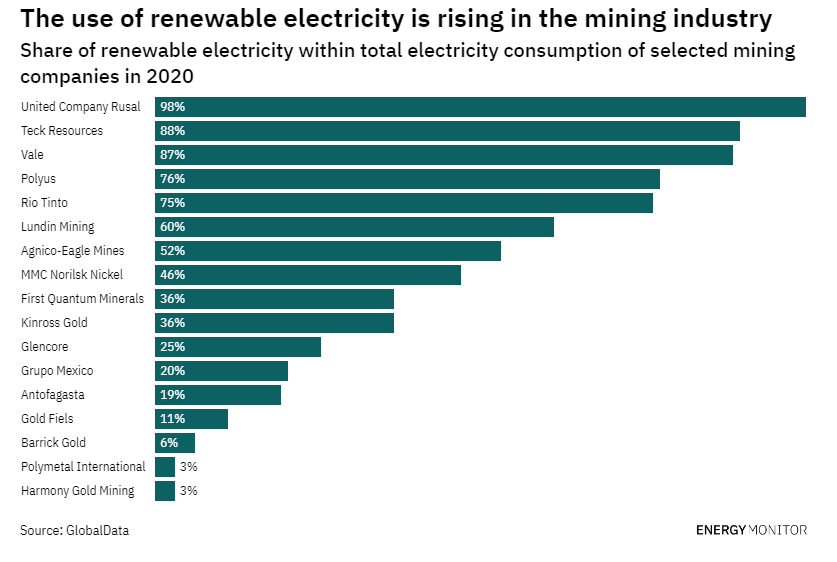
Sustainable Mining and beadedstream’s approach
In conclusion, the mining industry is here to stay and it will become increasingly relevant in the global energy transition. However, mining companies are expected to have a strong environmental, social, and governance (ESG) performance to remain competitive in the green future17. Strong ESG performance is being demanded by local communities, environmental groups and investors, alike. Implementing climate-smart mining practices and solutions is imperative if mining companies want to remain relevant and profitable in the long term.
beadedstream understands the pressure the mining industry is dealing with. This is why we continue to explore ways for how our remote temperature monitoring system could help our clients increase operational efficiencies through digitalization of data. Our digital thermistors, solar-powered data loggers, and cloud-based project management dashboard allow for the collection of reliable temperature data in real-time, anywhere in the world. And with an API connection to the mine’s broader data management platform, beadedcloud can seamlessly stream data for cross-functional usage.
To learn more about how our temperature monitoring solution can help your mining projects, contact our sales team at contact@beadedstream.com.
References:
1IEA. (n.d.). The Role of Critical Minerals in Clean Energy Transitions. https://www.iea.org/reports/the-role-of-critical-minerals-in-clean-energy-transitions/executive-summary
2IEA. (2021, May 4). Minerals used in electric cars compared to conventional cars. https://www.iea.org/data-and-statistics/charts/minerals-used-in-electric-cars-compared-to-conventional-cars
3IEA. (2021, May 5). Minerals used in clean energy technologies compared to other power generation sources. https://www.iea.org/data-and-statistics/charts/minerals-used-in-clean-energy-technologies-compared-to-other-power-generation-sources
4The World Bank. (202, May 11).Mineral Production to Soar as Demand for Clean Energy Increases. https://www.worldbank.org/en/news/press-release/2020/05/11/mineral-production-to-soar-as-demand-for-clean-energy-increases
5El Baz, O. (2020, September 22). The Role of the Mining Industry in the Energy Transition. https://infomineo.com/mining-industry-in-energy-transition/
6Stephenson, A. (2022, April 11). Global EV demand creates once-in-a-generation opportunity for Canadian mining sector. https://www.cbc.ca/news/canada/calgary/minerals-mining-metals-ottawa-nickel-electric-vehicles-1.6415887
7Li, Y. and Gilbert, J. (2022, May 24). Hunt for Lithium Sparks Frantic Rush Into Argentine Mountains. https://www.bloomberg.com/news/articles/2022-05-24/lithium-demand-for-ev-batteries-pushes-argentina-mining
8Henderson, K. et. al. (2020, January 28). Climate risk and decarbonization: What every mining CEO needs to know. https://www.mckinsey.com/business-functions/sustainability/our-insights/climate-risk-and-decarbonization-what-every-mining-ceo-needs-to-know
9Research and Markets. (2022, April 5) Global Connected Mining Market (2022 to 2027) – Increasing Demand for Digitalization to Boost the Market. https://www.globenewswire.com/en/news-release/2022/04/05/2416447/28124/en/Global-Connected-Mining-Market-2022-to-2027-Increasing-Demand-for-Digitalization-to-Boost-the-Market.html
10GlobalData Thematic Research. (2021, June 7). Cloud Computing in Mining- What’s Happening. https://www.mining-technology.com/comment/cloud-computing-mining/
11NewScientist. (2021, September 22). How electrification is changing mining. https://www.newscientist.com/article/2290944-how-electrification-is-changing-mining/
12The Mining Association of Canada. (n.d.). Newmont’s All-Electric Borden Mine. https://mining.ca/resources/canadian-mining-stories/newmonts-all-electric-borden-mine/
13van Halm, I. (2022, May 5). Mining sector commits to ESG, but more action is needed. https://www.energymonitor.ai/policy/mining-sector-commits-to-esg-but-more-action-is-needed
14Rio Tinto. (n.d.). Our first solar plant to power new iron ore mine. https://www.riotinto.com/en/news/stories/First-solar-plant
15Jamasmie, C. (2022, April 6). BHP’s Nickel West to be fully powered by renewables. https://www.mining.com/bhps-nickel-west-to-be-fully-powered-by-renewables/#:~:text=BHP%20has%20been%20steadily%20shifting,mine%2C%20entirely%20on%20renewable%20power.
16Anglo American. (2021, April 15). Anglo American secures 100% renewables across South American operations. https://www.angloamerican.com/media/press-releases/2021/15-04-2021
17Mining.com. (2022, May 19). ESG to decide winners-losers in mining, says Friedland. https://www.mining.com/web/esg-to-decide-winners-losers-in-mining-says-friedland/








